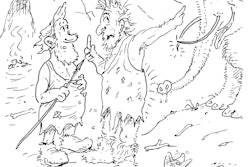
Can radiology be funny? Most definitely, says Dr. Paul McCoubrie, whose new book confirms that while radiology is an extremely stressful and mentally demanding profession, it can also be a great source of laughter and wit.
McCoubrie -- a consultant radiologist in Bristol, U.K., and regular columnist on AuntMinnieEurope.com -- has recently published the first volume of his Rules of Radiology, in which he educates, guides, and amuses his readers, while telling us the essential stuff that's often said in private conversation among ourselves but rarely committed to print.
Lighthearted and humorous cartoons are an essential aspect of this book. We published four of them last week in the article by Dr. Adrian Brady, and here are seven more radiology cartoons for you to enjoy.
 Always finish your cuppa before the next task, McCoubrie recommends. "Rushing things causes errors. Stay calm, stay safe. If the patient has a cardiac arrest in the department, it isn't strictly a radiological matter. Whilst it is polite to show an interest, they'd be honestly better off with the crash team." Illustrations by John Charlesworth. All figures courtesy of Dr. Paul McCoubrie and Springer.
Always finish your cuppa before the next task, McCoubrie recommends. "Rushing things causes errors. Stay calm, stay safe. If the patient has a cardiac arrest in the department, it isn't strictly a radiological matter. Whilst it is polite to show an interest, they'd be honestly better off with the crash team." Illustrations by John Charlesworth. All figures courtesy of Dr. Paul McCoubrie and Springer. Not all patients are stoical. "Merely unsheathing a tiny 25 g needle (0.5 mm in diameter) causes some to faint clean away," McCoubrie quips. "Approach some with a lubricated enema tube and they bolt for the door before you have time to say 'floccinaucinihilipilification.' Some tend toward the dramatic; wailing and flailing in a manner that can be surprising if you weren't expecting it."
Not all patients are stoical. "Merely unsheathing a tiny 25 g needle (0.5 mm in diameter) causes some to faint clean away," McCoubrie quips. "Approach some with a lubricated enema tube and they bolt for the door before you have time to say 'floccinaucinihilipilification.' Some tend toward the dramatic; wailing and flailing in a manner that can be surprising if you weren't expecting it." Most radiology departments have grown over decades without any planning at all, sprawling around the hospital like a drunk octopus, according to McCoubrie. "It wasn't deliberately done to confuse interlopers, just haphazard multiple phases of building. Consequently, once you stepped away from the waiting room, you discovered a veritable maze ... and plunged into the bowels of the radiology department, half expecting a minotaur at its heart."
Most radiology departments have grown over decades without any planning at all, sprawling around the hospital like a drunk octopus, according to McCoubrie. "It wasn't deliberately done to confuse interlopers, just haphazard multiple phases of building. Consequently, once you stepped away from the waiting room, you discovered a veritable maze ... and plunged into the bowels of the radiology department, half expecting a minotaur at its heart." To practise radiology in today's environment is to have the spectre of litigation and the demon of complaints sat on either shoulder as you work. "Well, it isn't, actually. It is that you imagine that they are there. Everyone talks about them so much that you imagine that litigation and complaints are commonplace. Newspapers inflate any medical misdemeanour into a full-blown scandal. The truth of the matter is that successful litigation and serious complaints are becoming more common but still relatively rare," McCoubrie says.
To practise radiology in today's environment is to have the spectre of litigation and the demon of complaints sat on either shoulder as you work. "Well, it isn't, actually. It is that you imagine that they are there. Everyone talks about them so much that you imagine that litigation and complaints are commonplace. Newspapers inflate any medical misdemeanour into a full-blown scandal. The truth of the matter is that successful litigation and serious complaints are becoming more common but still relatively rare," McCoubrie says. Turfing patients out. "A hospital I worked in had a 'hand-back' scheme. If a patient was readmitted that had been previously under your team, they were handed back to you. It was therefore in your best interests to make sure this didn't happen," McCoubrie writes. "The secret to slick healthcare is not heroics of the individual. Brain and brawn count for little. It is being organized and methodical. It is working in a system that encourages this through subtle incentives and rewards."
Turfing patients out. "A hospital I worked in had a 'hand-back' scheme. If a patient was readmitted that had been previously under your team, they were handed back to you. It was therefore in your best interests to make sure this didn't happen," McCoubrie writes. "The secret to slick healthcare is not heroics of the individual. Brain and brawn count for little. It is being organized and methodical. It is working in a system that encourages this through subtle incentives and rewards." Certain catches are impossible because the ball comes so fast that you cannot react. "The perfectly well-trained radiologist will occasionally metaphorically drop the ball," says McCoubrie. "Radiology isn't like catching a ball. It is more complex than a simple psychomotor task. There are four main things that can go wrong: Observer error, error in interpretation, failure to give guidance, and failure to communicate in a timely and appropriate manner. Failure of just one of these factors can result in error."
Certain catches are impossible because the ball comes so fast that you cannot react. "The perfectly well-trained radiologist will occasionally metaphorically drop the ball," says McCoubrie. "Radiology isn't like catching a ball. It is more complex than a simple psychomotor task. There are four main things that can go wrong: Observer error, error in interpretation, failure to give guidance, and failure to communicate in a timely and appropriate manner. Failure of just one of these factors can result in error." Enter the consultant surgeon. She wants to look at a scan and has tracked you down. She struts into our dimly lit workspace, fresh from the melee of clinical practice, all bustle and activity, steam metaphorically arising from the ears ... Within 15 seconds, the head slumps back onto the headrest, the shoulders unwind, the eyes close momentarily, and they sigh wearily. "Some surgeons get so comfy that they kick off their shoes and curl up slightly. I've stopped short of offering a blanket and mug of cocoa," writes McCoubrie. "Positive collaboration and cooperation with clinicians is the only way to get good health outcomes. And it is for this reason that radiologists must forgive the sins of the clinician."
Enter the consultant surgeon. She wants to look at a scan and has tracked you down. She struts into our dimly lit workspace, fresh from the melee of clinical practice, all bustle and activity, steam metaphorically arising from the ears ... Within 15 seconds, the head slumps back onto the headrest, the shoulders unwind, the eyes close momentarily, and they sigh wearily. "Some surgeons get so comfy that they kick off their shoes and curl up slightly. I've stopped short of offering a blanket and mug of cocoa," writes McCoubrie. "Positive collaboration and cooperation with clinicians is the only way to get good health outcomes. And it is for this reason that radiologists must forgive the sins of the clinician."


















